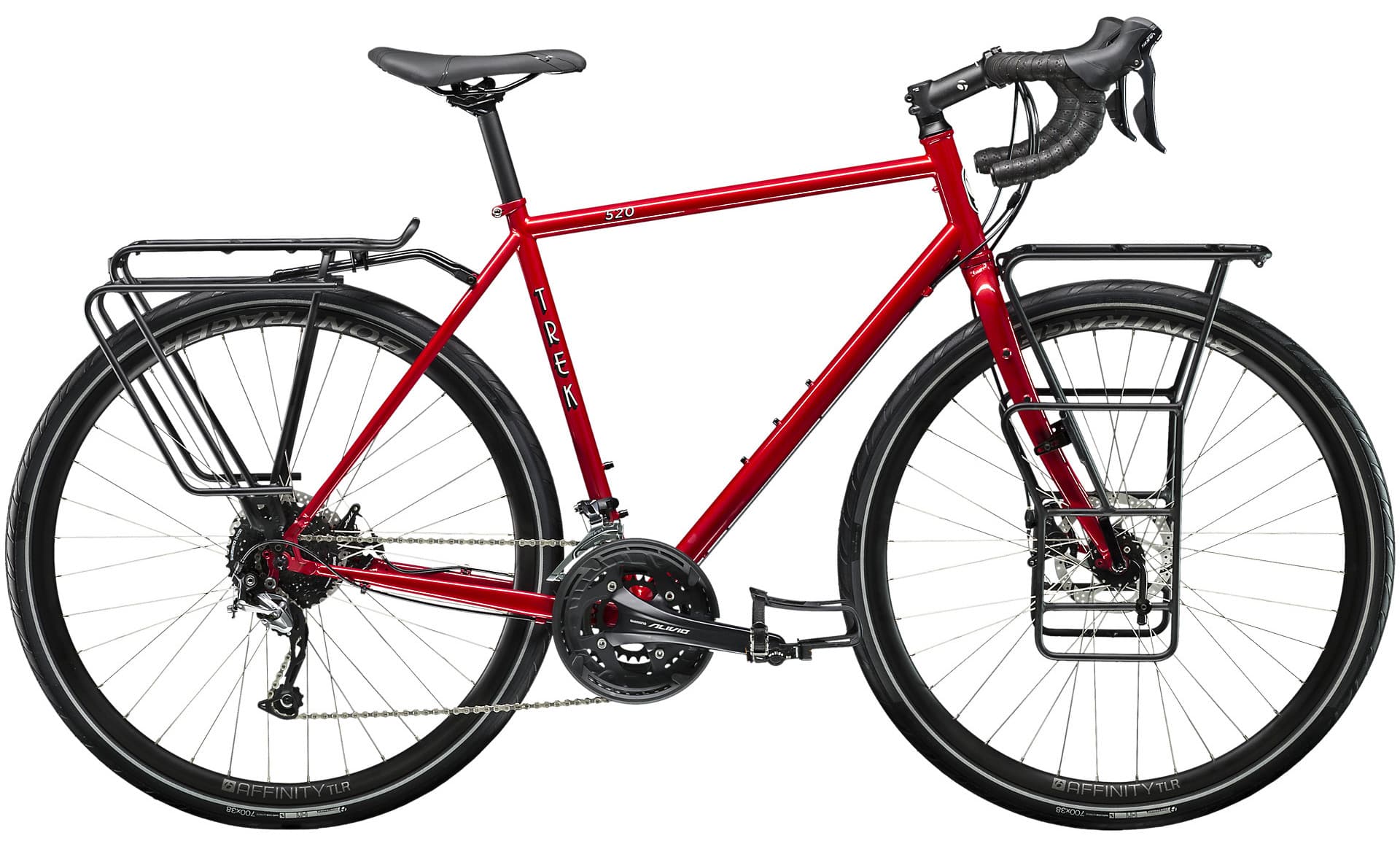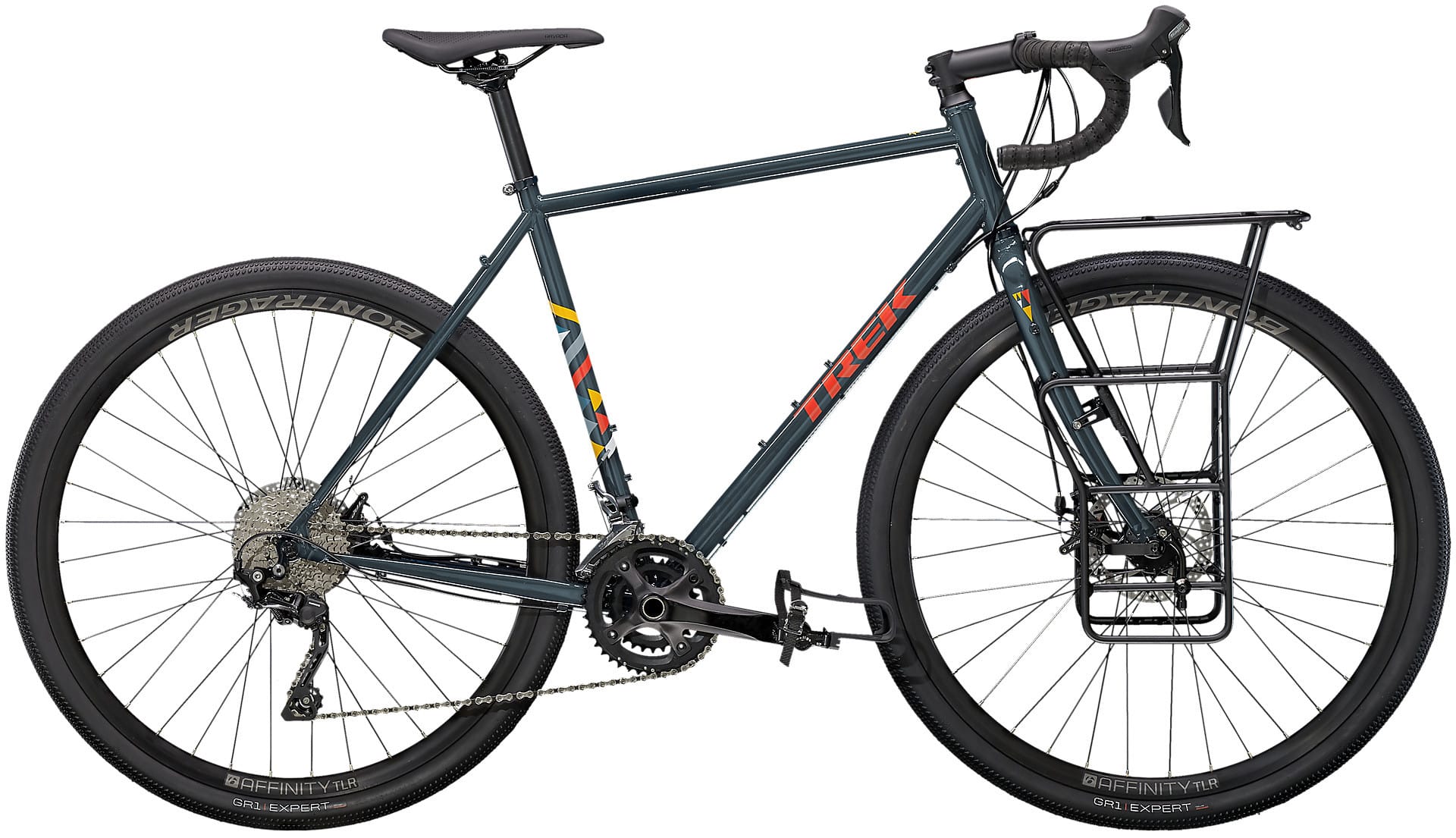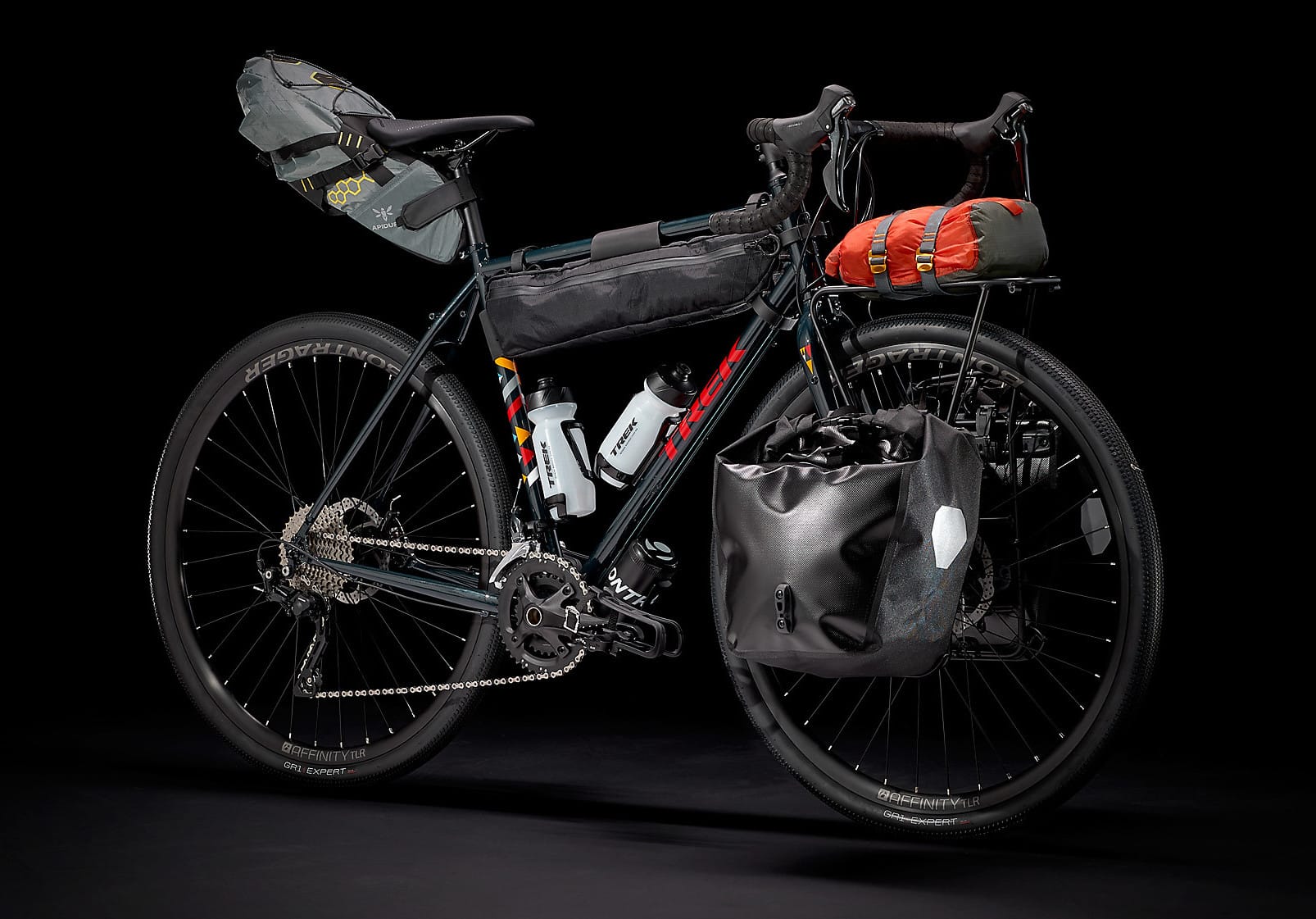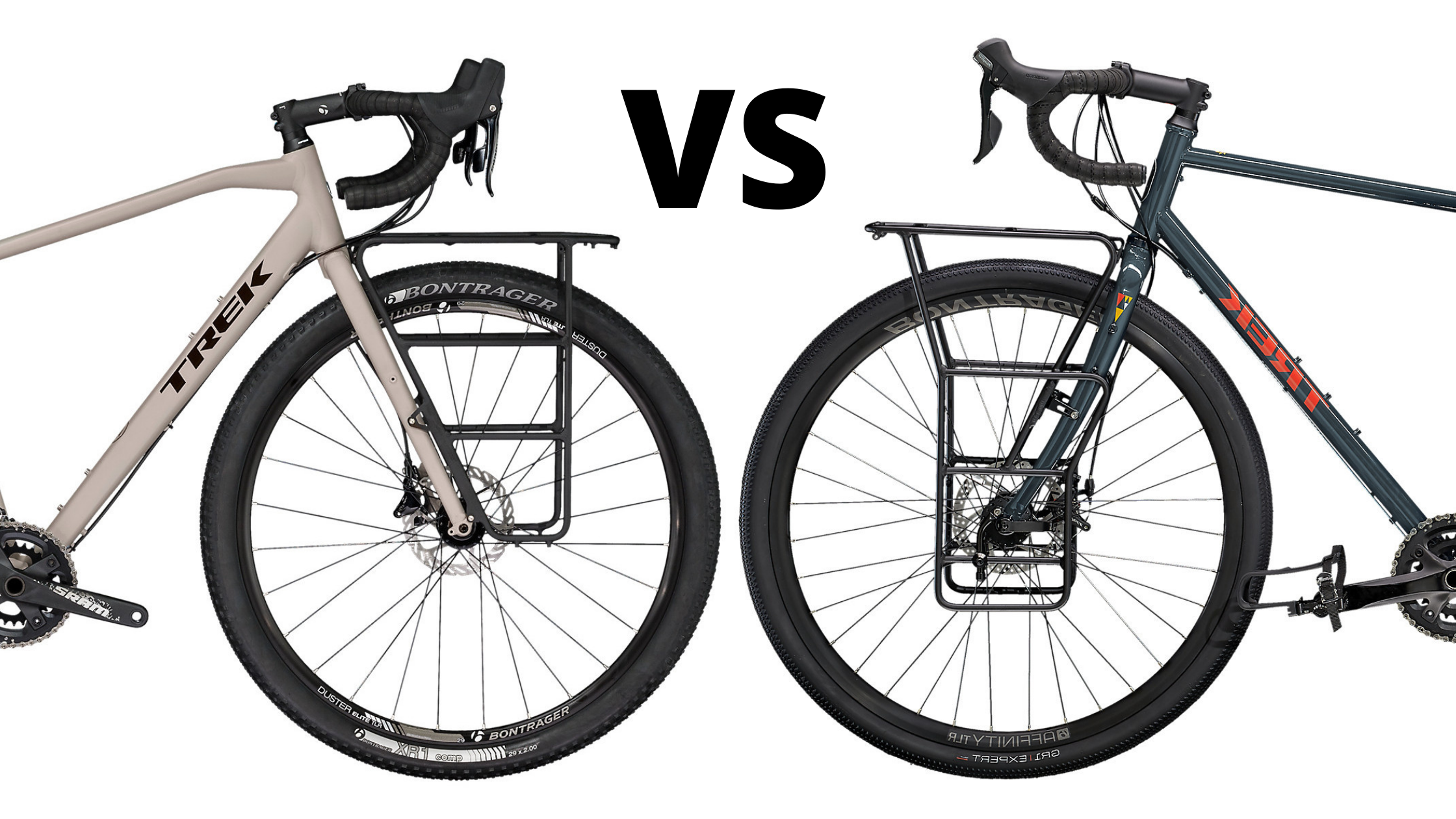The Trek touring bike battle! So which bike is better? We are going to compare each of these well established touring bikes side by side and see what the difference is between them. When it comes to price the Trek 520 is $420 cheaper at $1679 when the Trek 920 is $2,099. But what really is the difference and which one is best for you and your riding goals?
To start off the Trek 520 comes in two new models for 2021. Either the 520 disc (which comes with a 3 x 9 Alivio, Sora groupset) or the 520 Grando (which is 900 grams lighter then the 520 Disc and comes with a 2 x 10 GRX 400, Tiagra groupset) we will go into detail about gear range, ratio and inches later to see what really is the difference for climbing. But that is the main difference between these two. Then Trek 520 Disc is their longest running bike in the lineup and has been a work horse for years when it comes bike touring, the more traditional touring bike if you like. With stable touring geometry that make it the perfect choice for loaded multi-day trips.
We will get into the detailed differences soon but essentially, the Trek 920 is consider a “go-anywhere adventure touring bike”. One would say more suited for bikepacking adventures than traditional road touring. Where this bike has 29er mountain bike wheels for balance and capability on any surface. Allowing you to explore those tracks less travelled.
Trek 520 Disc

The Trek 520 Disc comes weighs in at 31.4 lbs / 14.2 kg which is rather average for a touring bike made from steel but this bike has a Aluminium fork. It does come out of the box with front and rear racks which has to be a huge plus. Not all touring bikes are sold with rack systems.
However the differences we start to see between this bike and the Trek 920 is that. the 520 has Mechanical Disc while the 920 runs Hydraulic Disc. That leads me onto the gearing. Again the Trek 520 comes with the 3 x 9 Alivio, Sora groupset. With the Shimano Alivio T4060, 48/36/26 crank with 175mm length. And a Shimano HG200, 11-36 rear cassette. Rolling on some Bontrager H1 Hard-case Ultimate, 700x38c tires. So what does this mean for the bikes gear range?
Using these details above, the Trek 520 has a huge range from a 19.79″ climbing gear all the way up to 119.81″ for the highest gear. So for example if you are riding downhill on the smallest cog and largest rear ring at 90 RPM you could reach a speed of 51.6 kph or 32.1 mph. But the best part about the gearing is the climbing gear. You want something this low for a bike that is going to be loaded with gear. Allowing you to climb effortlessly. If you plan to ride fully loaded with 20kg or more gear on the bike anything under 20″ for the granny gear is ideal. This bike can do that!
Consider the Trek 520 Disc as a bike ideal for fully loaded road touring. Priced at $1679.99 If you want something that is a bit lighter and you only plan to carry a lightweight touring gear setup then the Trek 520 Grando, might be your cup of tea!
Trek 520 Grando

The Grando fits somewhere in the middle between the like of the 520 (traditional touring bike) and the 920 (off adventure bike). It is considered a “steel adventure bike made for off-road excursions”. Trek coined the terms “gravel randonneuring” to describe this bike. Bringing back the spirit of the classic rando bikes. This rig is ideal for bikepacking and gravel riding.
The only real difference between the Grando and the 520 Disc is the obvious aesthetics, groupset and saddle. Plus you only get the front rack with the Grando but it is more suited to lightweight adventure cycling. So that leaves room to fit a saddle bag and other bikepacking bags.

The Grando is lighter at 29.3 lbs / 13.3 kg you get the same Steel frame and alloy build. But just different colours and frame aesthetics. The gearing though? Isn’t the 2×10 GRX 400, Tiagra groupset more limiting? Let’s take a look! So you get the ProWheel forged alloy, 42/28 crank which is a 175 cm length. And the Shimano HG50, 11-36 cassette. With slightly wider tires more suited fro gravel grinding. The Bontrager GR1 Expert 700x40c tires. Which gives you a 21.56″ climbing gear and 105.58″ highest gear. So this means when riding downhill at 90 RPM you should hit around 45.5 kph or 28.3 mph.
Yes it is slightly more limited then the 520 Disc but you are not carrying as much gear. If you are running say front panniers and up to 10 kg of gear anywhere around 25″ on the granny is ideal which is what I would recommend for this bike. The Trek 520 Grando is priced the same at $1,679.99
However if you plan off road touring you want something around 18″ climbing gear which this bike doesn’t. Which leads me to the Trek 920!
Trek 920

The Trek 920 is an adventure touring bike that is capable at taking you just about anywhere. A lighter bike out of them all coming in at 28.4 lbs / 12.9 kg, thanks to the all aluminium frame and fork build. With Hydraulic Disc and 29″ wheels and with the Bontrager XR1, 29 x 2.00′ tires. It is the most preferred bike of choice if all you want to go is off-road!
The 920 comes with the Bontrager Duster Elite, Tubeless Ready, 100x15mm thru axle rims compared to the Trek 520’s Bontrager Affinity Disc, Tubeless Ready, 36-hole, 21mm width rims.
The main difference again comes in the groupset with the 2 x 10 GX, X5 option on the 920. Which is considered a high-end component level compared to the 520’s mid-range component level. The Trek 920 has a ProWheel forged alloy, 42/28 crank with 170 mm (5mm shorter then the 520 crank arms) and a SRAM PG-1030, 11-36 cassette. Resulting in a 22.22″ climbing gear which actually in theory is not any better than either the 520 Grando or 520 Disc when it comes to climbing. And a 108.82″ largest gear. Yes the Trek 920 has better quality components but their range is not better. If you are wanting to save money, I really think the 520 Grando is a capable bike. When it comes to riding at 90 RPM downhill on the largest gears you can expect around 46.9 kph or 29.1 mph. Priced at $2,099
Tire Clearance
But wait we have not discussed tire clearances. If a bike has room for wider tires this can allow your ride to feel more supple and gain you access to rougher roads with ease. And we have not discussed geometries yet. From my research the Trek 520 has clearance for up to 29 x 2.0’’ tires of 700c x 50 mm. While the Trek 920 can fit up too, 2.3″ without fenders or 2″ with fenders.
Geometry – Trek 520 Vs Trek 920
Want to learn more about understanding bike geometry? Read this article which goes through all the jargon and what it means for a comfortable ride!
Geometry can play a big part in the difference of how I bike rides and feels. It is definitely something to consider when buying a bike. On first impressions the Trek 920 seems to have more of a MTB geometry and the 520 has a dailed in touring geometry all the way back to 1983. But after looking at the specs the 920 has features of a touring bike geometry with upright positioning and long wheelbase and chainstays.
So I have compared all geometry measurements for both bikes to see where they differ. Please note that both the 520 Disc and the 520 Grando have identical measurements. But all the measurements below are in mm and are for both 54 cm sized bikes.
| Bike | Trek 520 | Trek 920 |
| Stack | 565 | 583 |
| Reach | 378 | 392 |
| Stack/Reach Ratio | 1.49 | 1.49 |
| Top Tube Length | 543 | 562 |
| Seat Tube Length | 512 | 490 |
| Seat Tube Angle | 73.8 | 73.8 |
| Head Tube Length | 140 | 120 |
| Head Tube Angle | 71 | 71 |
| BB Drop | 70 | 85 |
| Front Center | 608 | 628 |
| Chainstay Length | 450 | 465 |
| Wheelbase | 1048 | 1079 |
| Rake | 52 | 55 |
| Trail | 65 | 68 |
| Standover Height | 768 | 760 |
Looking at the numbers above you can see Trek have been able to match some of the 920’s measurements with their classic touring geometry of the 520. With the same 1.49 stack/reach ratio. Making it a rather upright riding position. Not as upright as something like the Surly Disc Trucker which has 1.57. With the same seat tube and head tube angles. Then we start to see some slight differences in the numbers. What does it mean? I will try and break it down for you.
The trails are fairly similar with a 3 mm difference. The 520 is on the edge of feeling predictable and stable with a 65mm trail which is what you want in a touring bike. The 920 has 68mm which makes it more stable but it is still not sluggish.
The chainstay has a 15mm difference. The 520 being shorter with 450 mm which makes it feel more chill in the rear. While the 920 has 465 mm which is on the long end, making the rear feel more stable. This results in a longer wheelbase on the 920 by 31 mm and a wider front centre by 20 mm. Meaning more weight distribution if you plan to load up the 920 and help you stay upright on some rougher road conditions. Also that 20mm extra room allows more room from toe striking the front wheel. Also the bottom bracket drop is lower on the 920 by 15 mm which lowers the centre of gravity to help even further for staying upright on the rough stuff.
Overall they are all great bikes and I highly recommend them for touring and adventure biking. But it really comes down to what you will be using your ideal bike for? Are you planning to road tour on tarmac and have front and back pannier setup (traditional touring)? Then the Trek 520 Disc is a good choice. If you want a taste of traditional touring but want to dip your toes in off-road adventure cycling, then the Grando might be your choice. But if you want to go full out bikepacking off-road and nothing else then the Trek 920 is the best option.
Honestly for the type of riding I like to do. Off-road adventures with some road riding. The Trek 520 Grando is my favourite. With the decent climbing gear and off-road capabilities. However it is not the lightest. If weight is most important then the Trek 920 is going to be your best best. But if you are looking for value for money and want to save $420 I recommend the Trek 520 Grando!



